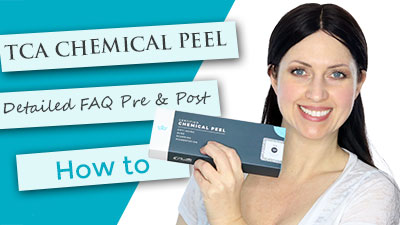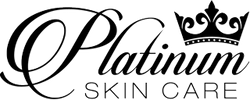
Transcript
TCA Peel Application and Detailed F.A.Q.
Today I am going to talk about and demonstrate how to properly do a TCA peel. I am going to address what TCA is good for, which percentage to choose, proper application procedure, how many layers to apply, What to expect immediately afterwards, skin needling, after care and also some alternative methods such as a full face peel + CROSS and also layering TCA with other acids. That’s a lot to cover, so lets get started shall we?
First, why TCA?
TCA or trichloroacetic acid, is one of my favorite acids ever. It is great for just about everything, Acne, hyperpigmentation and melasma, wrinkles, and scarring to mention a few.
What makes it so special is the fact that it can be customized for your skin. Unlike hydroxy acids that can only be applied one time and then get rinsed - TCA can be applied in layers.
It can be a mild peel (with only 1 or 2 layers or a very light application) or it can become a very strong peel if we apply the acid heavier or add on more layers. All these options with the same bottle. See the benefit?
How do you prepare for a TCA peel?
You always want to prepare your skin for a TCA peel. We want your skin to be healthy and exfoliated before we apply an acid. Also, if you have more melanin rich skin, we want you to prepare with a melanin inhibitor such as our Fade Bright for at least 2 weeks prior to a TCA peel. This will help to avoid Post Inflammatory Hyperpigmentation. Nothing is ever 100% - but this helps immensely.
The perfect product to prepare your skin with is our Retinol Molecular Serum every evening to even out the skin. I suggest the .20% for most people or the .10% if you are very sensitive. *If you have prescription Tretinoin that is great too! Another alternative would be an acid serum like our Serum 15 or Serum 30. What we DON’T want you doing to exfoliate is face scrubs. When you use a scrub you will press harder in some areas and get an uneven texture. Leave the smoothing to an acid or vitamin A instead.
Then daily protect your skin with antioxidants such as Vitamin C and always wear a broad screen SPF of at least 30 and*preferably 40 or 50.
If you have pigmentation or darker skin, don’t forget to use the Fade Bright 2x per day along with the above mentioned items. This is SO important.
Which percentage of TCA should I use?
We have 4 percentages of TCA. 7%, 13%, 20% and 30%. We recommend the 7% for those that have extreme sensitivity or want to do the eye area. *See our Eye Peel Video for an explanation and application.
The 13% is generally the best place to start – and that is what I am going to apply today. Once you reach a point where you are applying 5 layers of the 13% regularly and want MORE action, then you can move up to the 20% we carry. The 30% is only for body usage, scar treatment or dilution.
A few warnings
- Vitamin A will cause extreme sensitivity. This doesn’t effect everyone, so if you have tough skin, feel free to use your product up to the day before you apply a TCA peel. If you are more sensitive … Stop usage of RetinA about 5 days prior to peel application. If you are using our Retinol you can stop a couple of days before.
- Stronger acids like TCA can cause unintended color changes in the skin. This is why we recommend the application of Fade Bright or another melanin inhibitor before a peel. It is less likely with lighter skin tones – but can happen to anyone at any time. *The higher the percentage the higher the potential of this occurring. Yet another reason to apply more layers of a lower percentage instead of jumping into a higher one.
- Do not use any scrubbing granules or abrasive scrub sponges for a few days prior to a peel. This will lead to uneven application of the acid as I explained prior.
- Do not use needling techniques the same week as a peel. If you perform needling, wait an entire week before applying any peels to your skin. The same thing goes for after care. Be done flaking 100% before you start needling again.
- Never apply a peel to tan skin. There is excess melanin and that can lead to spotting.
- Do not apply TCA if you are pregnant.
- Do not apply to skin that has been waxed or shaved within 24 hours.
- Do not use TCA if you have been on Accutane in the past year.
- Do not apply TCA if you are unhealthy or have active herpes simplex. You may apply a peel after you are on a preventative prescription only.
When is the best time to do a TCA peel?
I always suggest to apply the peel in the evening. This gives your skin time to calm down and possibly even return back to its normal coloring before you have to go somewhere. It also allows you to apply healing products that will sit on all night long helping your skin.
Now let’s get onto the application.
I want to mention that if you have extremely sensitive skin you can use a numbing agent prior to any chemical peel. Any of the “caine” products work well. Just follow their instructions. I have a Lidocaine and Prilocaine cream here. It states to apply a thick layer up to 1 hour before a procedure. Most times this will work within 10-20 minutes though. Once your time is up. Wipe it off and wash your face 2x with one of our acid cleansers to get all of the cream off.
Now, onto the acid.
I used our AB Cleanser to wash and then just patted my skin dry.
Next is prep. Wipe the Prep B solution over all areas that you would like to peel. *If you do not have our solution you can use alcohol in its place. It won’t have the numbing properties, but it will strip the skin like it needs to be.
Follow Me. We will go horizontally working our way from the Top – Down.
Forehead
Now down temples and between the brows
And now we continue down the face.
If you aren’t applying the acid down your neck – you can just feather this down a little bit. If you are going down the neck and onto the chest *which I highly recommend, then just apply everywhere until all areas have been covered.
Let that air dry
Now it is time for the TCA and I want to make a BIG point here about how wet your gauze pad needs to be.
The Drier the pad the lighter the peel. We want the pad to be WET but NOT dripping. If we have a super wet, drippy pad.. we will get a much deeper peel than we intended. This is because your skin’s proteins have to process every drop of the solution before it neutralizes. If there is too much liquid it will just keep going and going.
SO… We want to wet our pad and THEN give it a squeeze. Now it is wet – but not dripping so our application will be even.
My pad is ready so I am going to apply the first layer just like I did the prep solution. Top to bottom.
Re- dip and squeeze as needed.
Once I am all done applying I need to wait 5 minutes for the TCA to react with my skin.
Ill set a timer and then we can talk about a few things…
By the 5 minute mark some people may see some blanching or frosting. If you see a white haze or white speckling on some or all areas – that is frosting. It is nothing at all to fear. It is just the skin’s proteins coagulating.
Some people never see frosting – and some people see it all the time. Even if you don’t see it – your skin will still peel.
Now that 5 minutes is up – I don’t see any frosting so I am comfortable to move forward with my second layer. If you see some… then decide if you want to move forward. If you stop here you will have a very light peel – which is perfect for many people.
If you have a very light amount of frosting, OR you only have a little bit in some areas … you can still move forward applying your next layer if you want a deeper peel.
Another option is to ONLY apply the acid to areas that do NOT have a frost on them.
If your face is mostly White then always stop.
Ok, time for the next layer. Notice that I am NOT rinsing. I am going to Rewet my gauze pad with more solution – give it a squeeze and apply just like the first layer.
Now we time it for another 5 minutes.
Now my time is up. I have evaluated my skin and I can move forward because I want a deeper peel. Again, … if your face is White then stop.
You may move forward with more layers... Explanation Follows:
Time for layer 3. Same thing. No rinsing and I am just reusing my previous gauze pad. The benefit here is that there is still some acid in the pad. I don’t have to completely saturate again. This saves me on my solution waste.
I’ll see you in another 5 minutes.
Time to evaluate. Things are looking good so I am going to apply a 4th layer. I want this to be a GOOD peel and I have done this many layers before.
Applying 4th …..
But… let’s say you are done at 3 layers and you are ready to rinse. Let me throw out a little BONUS idea for you called Spot Treating.
Spot treating is when you ONLY apply the acid to a tiny spot – say a frown line on your forehead or your nasal labial folds. Here is the time where you can add an extra layer ONLY to your target problems. Basically hit them harder with an extra layer – or even more. Consider that before you rinse. It might be just what you need to get the results you are looking for.
Now, just to show you what I am talking about I am going to do a spot treatment. I don’t want to do another layer on my whole face .. but I really want to target the nasal labial folds and my forehead. So here I will just use a Q-tip and swipe the solution on where I need it.
Now another 5 minutes and we will rinse well with super cold water.
I like to keep a bowl with ice water and a washcloth. Keep rinsing and patting until your skin feels good again – it will. There is no need to rush this. Now, pat your skin dry and we move onto after care.
This is a great time to apply any targeted treatments you have. Growth Factors, copper and even our .50% retinol Luminosity are great to use as they will penetrate deeply and give you amazing benefits.
I am going to apply our Regenerate Epidermal Growth Factor, Fade Bright serum and our Luminosity. *If you are dealing with hyperpigmentation or have darker skin, then a layer of Fade Bright is also recommended at this point.
If you like, you can apply the emu oil or our Essentials 99% Organic Healing Oil on top. Both are very healing and anti-inflammatory. If you don’t have either of those, any other calming or gentle cream or oil should be just fine.
We are done! Now let’s move on to after care and alternate application methods
Let me answer a few questions that I know you will have after a TCA peel.
How long is this frosting (or pink skin) going to last?
Most of the time the white haziness will go away in 15-30 minutes, but it can definitely linger longer so don’t be alarmed if 1 hour later you look in the mirror and it is still there. It won’t last forever. After the frosting goes away you may notice your skin is a bit pink – that is normal as well.
Your skin can be a bit pink after the peel with or without a frost. This is normal and will go away quickly. In a few hours you will not be able to tell that you did a peel at all today.
I want to mention swelling.
If you are applying a stronger percentage, such as the 20% in layers, you could potentially see some swelling in the skin the following day. This is more common if you are close to the eye area or are extremely sensitive from retinA usage. A cool compress should help and it will generally go away in a few hours.
Why are my spots looking darker or why am I seeing dark patches?
If you are already dealing with hyperpigmentation you will notice that they will become darker. This is temporary and can happen with many people. It is the pigment dumping into the upper layers. This is actually something GREAT if you are dealing with spots as they will be flaking off in the next week or so.
Will this get all of your pigmentation in a single peel?
Most likely not. Pigmentation runs very deep and can take an entire series of 8 – or more to get rid of. With peels it is not a one-time event. Continue on and things will improve. Have patience and continue your daily treatments in-between peels.
Another reason for darkness in the skin is that it is dead skin. Dead skin tends to turn darker before it flakes. Some people will see this and others will not. It is more prone in those doing several layers or a higher percentage. Just like before, the darkness will flake away once the skin starts peeling.
How long will it take for the skin to peel?
On average FACIAL skin will start to get dry and just start the peeling process on about day 3 or 4 after the peel. It will start around the nose and mouth and will radiate outwards over the course of the next 4-6 days.
Neck and chest will take longer to flake. Generally they will just have a rough texture and you won’t see large flakes. Expect this to start around day 6-10 and then go on for another week or so.
Body peeling will take up to a month to peel. It can be 2 weeks or more before you see any dryness at all. Please watch our video on Body Peeling to learn more about that.
How can I make it peel faster?
Here is where our Luminosity Method comes in handy. Not only does it give your skin a great boost of vitamin A immediately after your peel, but if you apply it for the next few days it will also help your skin to peel more quickly. So we highly recommend that and offer an easy way to purchase that right on our TCA peel page.
Another way to help those last bits of skin to come off is to use an Enzyme Mask. Enzymes ONLY target dead skin, so they are super beneficial to apply when you want to get this excess skin off. I like to apply a mask every day after about day 5 to help remove the last flakes.
How often can I do these peels?
This depends entirely on what percentage you are using and how many layers you are applying. Follow our recommendations in your peel manual that comes with your peel. On average, most people can do 1-2 peels per month.
Now, I want to give you some alternate methods to apply TCA. .
The first thing I want to talk about is mixing the TCA CROSS method along with your full face peel. *** Watch our Video on TCA CROSS for a full demonstration here.
CROSS – or chemical reconstruction of skin scars is when you use a high percentage of TCA and apply it directly IN-to the scar with a wooden pick. We recommend the 30% TCA for this method.
But, how do you apply this when you also want to do a peel on your whole face?
Simple. Always perform your CROSS method first. Wait your 5 minutes and then you can start applying the lower percentage of TCA to your full face like I just demonstrated. *Yes, it will get into the scars you just treated – that is OK.
Remember you can ONLY do the CROSS method one time every 5 weeks, so you will not be performing both at the same time often. Keep track of your applications in the back of your Manual so you know when to do it again.
Now I want to talk about mixing TCA with Jessners – which is fairly commonly done.
In this combination the Jessners is used mostly for stripping and preparing the skin for the TCA.
You will wash the skin and then pat dry.
Next apply 1-2 coats of Jessners solution waiting 5 minutes in-between each layer.
Now, move onto the TCA of either a 7% or 13%. You can apply another 2-3 layers of this.
Finish with the last 5 minutes and then rinse well and apply your Luminosity for the very best results.
Ok, I believe I have gone over everything I can think of about TCA peels! Really they are not any harder than a hydroxy application – you just get to apply more layers to customize it to your liking.
Personally… I LOVE that.
If you have any more questions about TCA we are here to help Monday – Friday from 9am – 5pm eastern time. You can speak directly with a representative as experienced as me!
Just reach out to us.
Have a great day!



